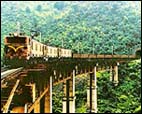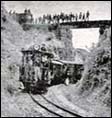Chugging into Chota Nagpur
... the oddball rail lines around Ranchi
Bill Aitken
 While a main line journey between Bombay and Delhi will reveal,
if not a plethora of little lines branching off from the straight
and narrow, then certainly a herringbone pattern between Godhra
and Billimora. The equivalent trunk travel east yields today only
one surviving feeder line of the lesser gauge. While a main line journey between Bombay and Delhi will reveal,
if not a plethora of little lines branching off from the straight
and narrow, then certainly a herringbone pattern between Godhra
and Billimora. The equivalent trunk travel east yields today only
one surviving feeder line of the lesser gauge.
Formerly at Dehri
on Sone at the privately operated Dehri-Rohtas Light Railway ran
to Tiura Pipradih while a sister concern steamed in the environs
of Patna. Now only at Barddhaman junction do you get a time-tabled
narrow gauge connection that leads (if you change trains) to the
legendary Ahmadpur, home of the best known complaint, issuing
from a dhoti-clad passenger caught short on a diet of jack-fruit
"running with lota in one hand while that damn guard
blowing his whistle with the other." (Barddhaman, lest those
bewildered by its lexicographical immaculate rebirth fail to place
it, is the common garden Burdwan gone brahmanical.)
While West Bengal yields rich pickings in steam culture thanks
to its proximity to the coal fields, its tourist infrastructure--at
least to the old tourist's bones -- leaves a lot to be desired.
It was for this reason that I skirted the heart of the golden
province and preferred the green delights of Jharkhand, passing
from the little line out of Ranchi to its interrupted section
at Purulia.
From Delhi I caught the Hatia-Tata Express that veered away from
the Gangetic line at Chunar as though drawn to the minerally rich
backwoods we now traversed at a very sedate gait. According to
a commercial traveller sharing the same compartment, to avoid
the big loop the train would make to gain the plateau at Ranchi,
we should alight at Daltonganj and take a bus.
 This travelling
companion was an amiable guide to the green passages our train
made through the thick jungle growth. Also he was well read and
particularly fond of capping his commentary with a well chosen
couplet from Palgrave's Golden Treasury. Apparently he wanted
to be a poet but the family insisted he succeed his father in
selling irrigation equipment to drought prone customers. Drought
was clearly not his problem for after the apt couplet he uncapped
a half bottle of rum and allowed himself a full-throated swig.
By the time we reached Ranchi the liquid intake and poetic outputhad reached the level of Dylan Thomas.
The Ranchi railway station catering to both broad and narrow line
traffic still wears a rural air in spite of the heavy industrial
throughput. Its station building is a charming pink stone composition
reminiscent of those crow-stepped exteriors that grace the West
Highland line of Scotland. Almost opposite is the beautifully
ensconced Railway Hotel which in colonial days vied with the
BNR hotel in Puri as the choicest home in the region. (The Ranchi
Hotel went by the name of "Beaner" though now its name
board announces affiliation with the South-Eastern Railway.)
 Much as I would have liked to put up in its lush compound, the
single-story buildings offered no hope of a peep over the high
wall which separated the road traffic from the fascinating railway
activity on the other side. To catch that, I booked into a modern
lodge next door whose flat roof-top permitted the perfect survey
of Ranchi's unique marshalling yard. The narrow gauge line ran
up a ramp above the empty broad gauge wagons waiting below and
by the simplest mode of gravity allowed the ore trains of the
lesser gauge to be transferred cheaply if noisily to a main line
destination. Much as I would have liked to put up in its lush compound, the
single-story buildings offered no hope of a peep over the high
wall which separated the road traffic from the fascinating railway
activity on the other side. To catch that, I booked into a modern
lodge next door whose flat roof-top permitted the perfect survey
of Ranchi's unique marshalling yard. The narrow gauge line ran
up a ramp above the empty broad gauge wagons waiting below and
by the simplest mode of gravity allowed the ore trains of the
lesser gauge to be transferred cheaply if noisily to a main line
destination.
|

